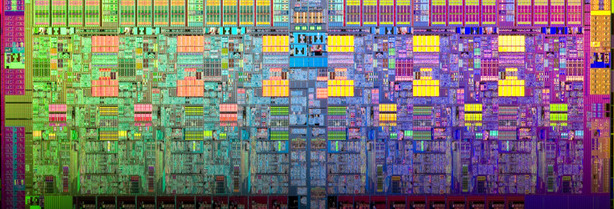Up Close: Intel Xeon X5600-series
The Xeon 5600-series is very much an evolution of the earlier Xeon 5500-series. Like its predecessor it’s based on the Nehalem EP architecture, although Intel has tweaked the core design from the original Gainestown so much it’s been given a new moniker – Westmere.The biggest change between Gainestown and Westmere is the addition of two more physical cores, bringing the total from four to six. As each physical core is accompanied by a logical Hyper-Threaded core, this means a Xeon 5600 CPU has 12 execution units to throw at your applications. This is a great advance, as while there are precious few consumer applications that require 12 execution units; workstation and server applications are much more heavily multi-threaded.
To handle the greater stress caused by the four additional execution units Intel has also increased the size of the shared Level 3 cache from 8MB to 12MB. However, Intel has stuck with the same triple-channel DDR3 controller, so you should still install DIMMs in multiples of three for the best performance. As before, you can use either 1,333MHz registered ECC DIMMs or standard unbuffered DIMMs, the former being recommended for a mission critical server due to its greater reliability. Like all Nehalem EP architecture CPUs, the Xeon 5600-series supports Turbo Boost, so the CPUs can automatically overclock themselves by a few hundred megahertz when not running at its maximum TDP.
What’s more, because the Xeon 5600-series shares the same LGA1366 packaging as the Xeon 5500-series, you can simply upgrade from a quad-core (eight thread) CPU to a six-core (12 thread) CPU right now with a simple motherboard BIOS update.

A close-up of the 6-core Westmere die at the heart of the Xeon 5600-series. Click to enlarge.
However, if you work in the security industry you may want to buy a new motherboard, as Intel has added two new features to the CPU instruction set that are only supported by a new revision of the Intel 5520 motherboard chipset. These two new instructions, AES (Advanced Encryption Standard) and TXT (Trusted Execution Technology) offer increased data encryption and better protection against malware by running applications in their own memory space, though to be honest we can’t see many users outside of the data centre upgrading just to get these features.
All these upgrades are possible because Intel has shrunk the transistors used to make the Westmere core from 45nm to 32nm. Smaller transistors are superior to larger transistors, because they consume and leak less power and so are more energy efficient. In addition, because they are physically smaller, there is more room in the die for more features, such as additional cores and cache. As a result, the top end models of the six-core Xeon 5600-series CPUs have the same 130W TDP as their quad-core Xeon 5500-series predecessors.
However, although all 15 models of the Xeon 5600-series are based on the 32nm Westmere core it’s important to note that not every model has six cores. In short, some of the low power models only have four cores, although they still have the full 12MB of Level 3 cache. The other oddity in the range is the quad-core X5677, which is clocked at 3.46GHz, 133MHz more than the fastest six-core model, the X5680. Presumably Intel developed this model as many workstation applications don’t scale particularly well above eight threads, but do love raw clock frequency. To help you pick the right Xeon 5600 for you we’ve summarised the main differences between the models in the table below.
| Model | Frequency | Physical cores | Logical cores | TDP | DDR3 support | List Price |
| X5680 | 3.33GHz | 6 | 6 | 130W | 1,333, 1066, 800 | $1,663 |
| X5677 | 3.46GHz | 4 | 4 | 130W | 1,333, 1066, 800 | $1,663 |
| X5670 | 2.93GHz | 6 | 6 | 95W | 1,333, 1066, 800 | $1,440 |
| X5667 | 3.06GHz | 4 | 4 | 95W | 1,333, 1066, 800 | $1,440 |
| X5660 | 2.8GHz | 6 | 6 | 95W | 1,066, 800 | $1,219 |
| X5650 | 2.66GHz | 6 | 6 | 95W | 1,066, 800 | $996 |
| L5640 | 2.26GHz | 6 | 6 | 60W | 1,333, 1066, 800 | $996 |
| L5638 | 2GHz | 6 | 6 | 60W | 1,066, 800 | TBC |
| L5630 | 2.13GHz | 4 | 4 | 40W | 1,066, 800 | $551 |
| L5618 | 1.86GHz | 4 | 4 | 40W | 1,066, 800 | TBC |
| L5609 | 1.86GHz | 4 | 0 * | 40W | 1,066, 800 | $440 |
| E5645 | 2.4GHz | 6 | 6 | 80W | 1,066, 800 | TBC |
| E5640 | 2.66GHz | 4 | 4 | 80W | 1,066, 800 | $774 |
| E5630 | 2.53GHz | 4 | 4 | 80W | 1,066, 800 | $551 |
| E5620 | 2.4GHz | 4 | 4 | 80W | 1,066, 800 | $387 |
* = Please note, the L5609 does not support Hyper-Threading, so has four physical cores, but no logical cores.

MSI MPG Velox 100R Chassis Review
October 14 2021 | 15:04









Want to comment? Please log in.